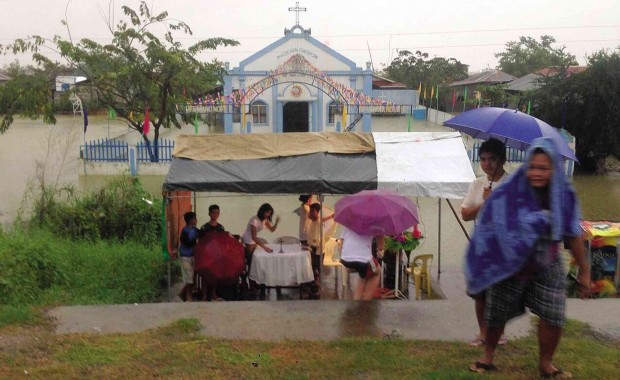Floods won’t break folk’s Christmas spirit

DAWN MASSES are still held at the eastern dike of the Pampanga delta development project where folks from Pampanga’s Masantol town take refuge when floodwaters from Nueva Ecija, Tarlac and Aurora spill toward the Pampanga River. MARCELO LACAP JR./CONTRIBUTOR
IT’S BEGINNING to look a lot like Christmas atop a Japanese-funded dike for 6,000 families, who will need to wait for floods to cross through their homes in seven coastal villages in Pampanga’s Masantol town before the waters flow straight to Manila Bay.
And that will not be a happy holiday for anyone of them, with nary a lantern nor a Christmas tree to brighten up their days as Christmas Day approaches.
“Makalunus ing bili mi (Our situation is pitiful),” said Marcelo Lacap Jr., 52, former vice mayor of Masantol who lives in Barangay Sagrada Familia.
Floodwaters in this village as well as in Nigui, Bagang, Balibago, Alauli, Baco (a subvillage of Bebe Matua) and Escondo (a subvillage of Bebe Anac) had risen to 4 to 5 feet past noon on Dec. 21. These communities are located at the base mound of the Pampanga Delta Development Project I (PDDP-1) dike.
“My neighbors have put all sorts of bed—wood, plastic, bamboo, mattresses, linoleum, card boards, tarpaulins—to be able to sleep on the dike. We can hardly sleep anyway because there are lots of mosquitoes,” said Lacap.
Article continues after this advertisementThey are not in too much discomfort. Electricity is available at a permanent evacuation center built by the Center for Emergency Aid and Rehabilitation (Concern) and its partner Ceci, a Canada-based disaster management institution. Solar lamps and chargers are available at the center.
Article continues after this advertisementConcern found partners to extend several faucets at the dike to make water available to evacuees, Lacap said. “We need comfort rooms at the dike itself,” he said.
But the floods will not break the communities’ Christmas spirit. Folks at the dike have been attending the traditional “Simbang Gabi” (dawn Masses), which are celebrated by Fr. Norman Arce and Fr. EJ Cruz.
It rained on Monday morning but that did not stop Catholic devotees from attending Mass, seeking cover in tents provided by the town government.
Temporary life
“We are used to a temporary life at the dike. We always take refuge at the dike,” Lacap said about the people’s tenacity. Rains always prompt residents to stock up on food, especially rice, he added.
Lacap said this was the first time that he and his village mates faced the prospect of spending Christmas on the PDDP dike, which is also called the Masantol eastern dike. At the edge of the dike is the open sea, marked by a few standing mangroves.
The PDDP dike was proposed by the United Nations in 1978 but was completed only in 2002 on Japanese loans. The antiflooding project widened the mouth of the Pampanga River, which drains 30 rivers in Central Luzon, from 75 meters to 750 meters.
The project displaced nearly 15,000 families and 500 schools, chapels and barangay halls,
according to data gathered by the Inquirer. Most of the displaced residents, although compensated for the project’s right-of-way,
opted to live on the base mound, which is actually a high water channel during high tide.
The top of the dike has been asphalted but loses its function as a road when the Candelaria earth road in Macabebe town is submerged in water.
The seven villages have been isolated since Friday and the only way to reach these areas is by boat that is strong enough to withstand the strong water current, Lacap said.
It was after Typhoon “Ondoy” in 2009 that the seven villages began experiencing a succession of two floods annually. These villages are at the mouth or delta, where land sinks at an average of two to three centimeters a year, according to a study.
Lacap said fishermen have appealed to the Department of Public Works and Highways (PDWH) to make a cut-off channel between Bebe Esteban in Masantol and Candelaria in Macabebe to hasten the flow of water to Manila Bay.
Solidarity
After urging solidarity with flood victims, Pampanga Gov. Lilia Pineda on Monday urged DPWH to stop talking about flood mitigation and buckle down to work.
“I have been governor for six years now. I hope the DPWH would act soon. Because they’re not dredging the downstream of the Pampanga River and is repairing only a few sections of the setback levee, I think it would be wise for us in the provincial government to use our P260-million savings in the calamity fund to buy a dredger,” she said. “We can’t wait anymore,” she added.
Antonio Molano, DPWH Central Luzon director, said a World Bank study has recommended creating two retarding basins in Candaba town in Pampanga and in San Antonio town in Nueva Ecija to ease flooding downstream.
The second phase of PDDP is ongoing with the dredging of the Labangan Channel in Calumpit town in Bulacan, he said.